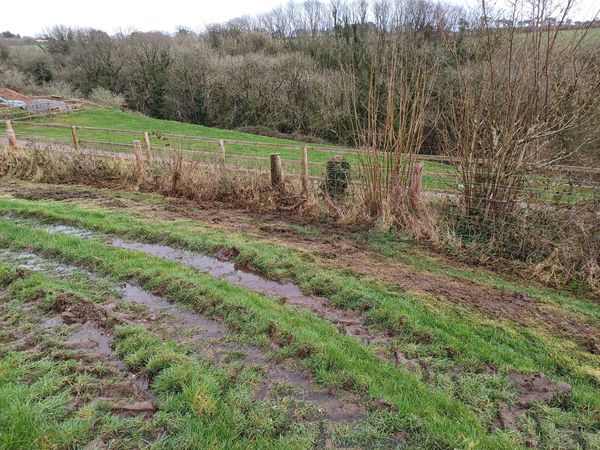The Sidmouth Arboretum were busy again over the weekend:
Planting another wildlife/slow the flow hedge, near the source of the Snod this time alongside the bridleway from Hatway Hill down to Lower Sweetcombe Farm. Apart from creating a future wildlife corridor, this hedgerow will play a vital role in the whole catchment run off project that is developing with other groups. The aim is to use sustainable interventions to slow run off from the higher ground of the valley after heavy rain. This will reduce flood risks and make the river healthier for the invertebrates and fish that have made it their home.

As you can see, the pasture is very wet and, if you look beyond the fence you can see it is only a short distance before the ground plunges down to the Snod. A series of hedgerows, leaky dams and other groundworks will be installed around the area at the top of the steep valley sides over the next few years. Apart from reducing flood risks, another benefit to holding water on the high ground is it makes the pastures more resilient in hot summer droughts.
Huge thank you to the eleven volunteers who… – Sidmouth Arboretum | Facebook
Also reported on the Herald’s online pages:
New hedgerow planted by Sidmouth Arboretum | Sidmouth Herald
This is part of the bigger ‘River Sid Catchment’ project – which has been gathering momentum:
Sid River catchment – The Sid [August 2022]
East Devon catchment – The Sid [October 2022]
Upstream Thinking on Devon’s rivers – The Sid [December 2023]
Jan Metcalf, member of the River Sid Catchment Group and the Sid Valley Biodiversity Group, spoke at the Town Council’s environment cttee meeting on Monday:
Environment Committee (12 Feb 2024) – Sidmouth Town Council
And her report is now publicly available, with a few highlights here, when at a recent meeting along the Roncombe Valley, Group members and…
Neighbours listened to Simon Browning, the Sid Valley Biodiversity Group’s catchment advisor, talking about possibilities for retaining water in the landscape and slowing its flow after torrential rain. This can benefit both individual landowners and those living downstream. Many small interventions across the valley could have an impact reducing soil erosion, improving climate resilience and reducing flooding downstream.
The possibility of a series of leaky dams on the Roncombe to raise the river bed and enable the river to reconnect with its old flood plain were also discussed. This is a national initiative; local similar projects include one on National Trust land at Killerton and the Lower Otter Restoration Project. Rivers often react badly to being straightened and used as conduits to channel water swiftly to the sea. This project gives the landscape the chance to hold back some of the runoff and people opportunities to reconnect with their natural world.
Agenda item 1a Roncombe residents
Finally, whilst there are indeed discussions and such like happening – there are no plans in place to install leaky dams as yet. Step-by-step…
…
